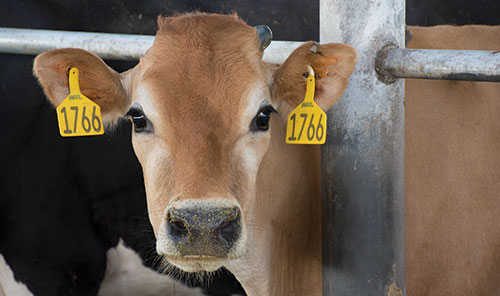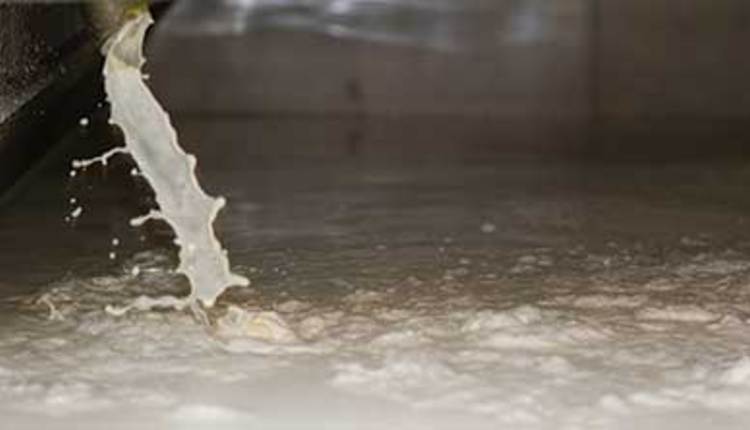The author is a director of marketing at Select Sires in the Mid-Atlantic area. He is also a graduate of the Young Dairy Leaders Institute.

Genetically engineering hornless cattle will be just the beginning of options to create improved cattle.
The ability to edit the genome of mammalian species is further along than many of us realize. Work at leading research universities around the world shows that we will be able to alter the genetic makeup of many animals within the next few years.
Without going into too much detail on the CRISPR technology that allows certain genes to be edited or eliminated from our animals, current researchers have the beginnings of a gene editing system that can transfect cells to eliminate stretches of DNA that we consider undesirable, eliminating the undesired trait or replacing it with a more desirable genetic pattern.
One of the first obvious moves in cattle would be to replace the gene that grows horns with a stretch of DNA carrying a "polled" profile. Producing only semen that has been genetically engineered to be "polled" or editing DNA in vitro to create "polled" cattle sounds like a great idea, and we would expect that the consumer anxious for dairy products from naturally dehorned cattle would beat a path to any company or farm that could produce milk with this new technology.
That is the irony of the situation as the same consumer anxious to see all cattle dehorned humanely will also typically balk at any product that is "genetically modified." It creates quite a conundrum in our industry knowing we have a technology that can offer a world of opportunity but also could lead to a world of pain.
Use the previous dairy marketing advantage as an example. Dehorning methods currently available have often been cited as an area of concern for dairy consumers, and much work has been done to come up with viable, humane methods for horn removal. Current natural selection methods have been effective, but the genetic sacrifice that some producers feel they have to make to utilize the current "polled" options available has restricted adoption.
Genetic engineering offers hope that a day is not too far away when the U.S. dairy herd would all be hornless at birth, lacking the genetic coding for producing horns because it was snipped out of the animal with a relatively simple process of gene editing.
This would eliminate a key argument that some consumers have cited as why they stay away from dairy and could open many new markets for dairy products around the world. But what if the tide turned and the consumer said we are not touching any dairy products with traces of that "Frankenstein milk"? As quickly as we gained an advantage, we lose our market, and this can happen no matter how safe the product. Perceptions are everything.
The challenge facing the adoption of this technology going forward will not be whether it works. There are enough examples from other species that show we will be able to develop gene editing technology to work in dairy cattle.
Our industry has numerous recent examples of effective technology that was eliminated because of consumer perception. In a hungry world, it would seem obvious that a safe tool that worked to meet a consumer demand would be welcomed with open arms. We now have enough experience to know that new technology is not always accepted simply because it is new and may not be understood. In a Twitter world where everyone has some access to influence, our industry should expect that gene editing technology will be under the strongest of microscopes.
Within our industry, we also have the right to ask where does the technology cross a line between being a positive influence and a negative disruption on the market. It is one thing to edit out an undesirable trait. What happens when an animal's genetic profile is enhanced with editing?
If we double the potential production of a bovine, simple math tells us that we need half of the animals to achieve the same amount of output. Is the dairy industry infrastructure prepared for less cows producing more milk controlled by fewer people? It is a path that we have already started down, but an acceleration of change would disrupt current markets, payment structures and labor needs.
The promise of genetic editing technology opens a new era of what it means to be a dairy farmer. Our industry has always strived for progress whether it was genetically, nutritionally, environmentally or one of the countless other ways to be a good caretaker of our animals. We now have a tool that can deliver additional benefits to our core consumer. Some of these benefits could be through animal welfare, and some could be production based through enhanced genetic profiles.
Our industry has many new competitors looking to cut in on the share of stomach that dairy now enjoys. The ability to produce milk more economically with an enhanced animal welfare profile should be an obvious step toward delivering a product that consumers desire.
However, the aforementioned alternatives available to today's consumer create a marketplace that is more segmented with options allowing a person making a purchase from the dairy case to be more finicky in their selection. Adopting this new technology will open new markets for dairy products to be consumed, but it will also present the potential for other markets to close and shift.
The technology will work, and the tool will be available. How you choose to adopt the tool on your individual farm and how that choice works into a larger dairy industry choice will determine what the dairy market will look like over the next five to 10 years. Past history tells us that the many variables involved will make that future hard to predict. An inability to predict should not stop a producer from preparing with education on the options available.
This article appears on page 235 of the April 10, 2016 issue of Hoard's Dairyman.
Return to the Hoard's Dairyman feature page.

The ability to edit the genome of mammalian species is further along than many of us realize. Work at leading research universities around the world shows that we will be able to alter the genetic makeup of many animals within the next few years.
Without going into too much detail on the CRISPR technology that allows certain genes to be edited or eliminated from our animals, current researchers have the beginnings of a gene editing system that can transfect cells to eliminate stretches of DNA that we consider undesirable, eliminating the undesired trait or replacing it with a more desirable genetic pattern.
One of the first obvious moves in cattle would be to replace the gene that grows horns with a stretch of DNA carrying a "polled" profile. Producing only semen that has been genetically engineered to be "polled" or editing DNA in vitro to create "polled" cattle sounds like a great idea, and we would expect that the consumer anxious for dairy products from naturally dehorned cattle would beat a path to any company or farm that could produce milk with this new technology.
That is the irony of the situation as the same consumer anxious to see all cattle dehorned humanely will also typically balk at any product that is "genetically modified." It creates quite a conundrum in our industry knowing we have a technology that can offer a world of opportunity but also could lead to a world of pain.
Use the previous dairy marketing advantage as an example. Dehorning methods currently available have often been cited as an area of concern for dairy consumers, and much work has been done to come up with viable, humane methods for horn removal. Current natural selection methods have been effective, but the genetic sacrifice that some producers feel they have to make to utilize the current "polled" options available has restricted adoption.
Genetic engineering offers hope that a day is not too far away when the U.S. dairy herd would all be hornless at birth, lacking the genetic coding for producing horns because it was snipped out of the animal with a relatively simple process of gene editing.
This would eliminate a key argument that some consumers have cited as why they stay away from dairy and could open many new markets for dairy products around the world. But what if the tide turned and the consumer said we are not touching any dairy products with traces of that "Frankenstein milk"? As quickly as we gained an advantage, we lose our market, and this can happen no matter how safe the product. Perceptions are everything.
The challenge facing the adoption of this technology going forward will not be whether it works. There are enough examples from other species that show we will be able to develop gene editing technology to work in dairy cattle.
The question will be how will the consumer treat the new techniques?
Our industry has numerous recent examples of effective technology that was eliminated because of consumer perception. In a hungry world, it would seem obvious that a safe tool that worked to meet a consumer demand would be welcomed with open arms. We now have enough experience to know that new technology is not always accepted simply because it is new and may not be understood. In a Twitter world where everyone has some access to influence, our industry should expect that gene editing technology will be under the strongest of microscopes.
It works, but do we need it?
Within our industry, we also have the right to ask where does the technology cross a line between being a positive influence and a negative disruption on the market. It is one thing to edit out an undesirable trait. What happens when an animal's genetic profile is enhanced with editing?
If we double the potential production of a bovine, simple math tells us that we need half of the animals to achieve the same amount of output. Is the dairy industry infrastructure prepared for less cows producing more milk controlled by fewer people? It is a path that we have already started down, but an acceleration of change would disrupt current markets, payment structures and labor needs.
The promise of genetic editing technology opens a new era of what it means to be a dairy farmer. Our industry has always strived for progress whether it was genetically, nutritionally, environmentally or one of the countless other ways to be a good caretaker of our animals. We now have a tool that can deliver additional benefits to our core consumer. Some of these benefits could be through animal welfare, and some could be production based through enhanced genetic profiles.
Our industry has many new competitors looking to cut in on the share of stomach that dairy now enjoys. The ability to produce milk more economically with an enhanced animal welfare profile should be an obvious step toward delivering a product that consumers desire.
However, the aforementioned alternatives available to today's consumer create a marketplace that is more segmented with options allowing a person making a purchase from the dairy case to be more finicky in their selection. Adopting this new technology will open new markets for dairy products to be consumed, but it will also present the potential for other markets to close and shift.
The technology will work, and the tool will be available. How you choose to adopt the tool on your individual farm and how that choice works into a larger dairy industry choice will determine what the dairy market will look like over the next five to 10 years. Past history tells us that the many variables involved will make that future hard to predict. An inability to predict should not stop a producer from preparing with education on the options available.









